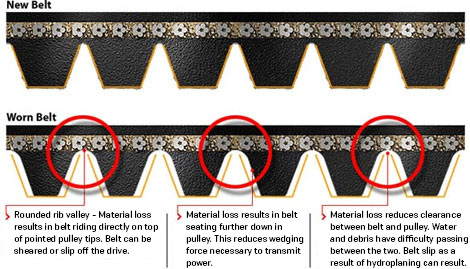A belt failure is the last thing you or your customer needs.
Especially if the car was just in the shop for some kind of service.
EPDM vs. Neoprene Construction
It used to be that a simple visual inspection of the belt would reveal problem areas like cracking, chunk-out and rib separation. Those kinds of things signalled that a replacement was needed. But today, a visual inspection isn't always enough. That’s because most belts today are made using EPDM (ethylene propylene diene m-class rubber) construction.
OEMs have been using belts made with EPDM since the late 1990’s. EPDM provides one significant benefit over older belts which used neoprene in their construction—they last longer. While longer life is an advantage, EPDM belts don’t necessarily exhibit traditional signs of wear even though they might be at or near failure. So, a belt that looks like it still has plenty of life, might not because much of the material has worn away.
Material Loss – The New Diagnostic Standard
In many respects, an EPDM belt is much like a tire. As a tire rotates and comes into contact with the ground, it wears. A belt wears much the same way - it comes into contact with pulleys as it moves around the drive system. Over time, the grooves cut into a belt gradually wear away.
This material loss results in weakened belt performance. Reduced tension is one example. This can lead to belt slip which causes severe vibration and a reduced ability to transmit power which often leads to inconsistent alternator performance or poor A/C system performance.

Best Practice
When is it best to replace EPDM belts? Visual inspection is still a good idea, but don’t look just for cracking or more traditional signs of wear. Look closely at the belt ribs for wear like flattening or thinning.
It’s also a good idea to replace the belt when other components like the tensioner, alternator, or water pump is replaced since there’s good a chance the belt doesn't have much life left in it. Plus, a good part of the labour charge for replacing a belt is already absorbed.